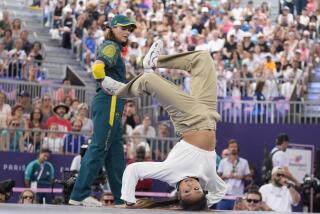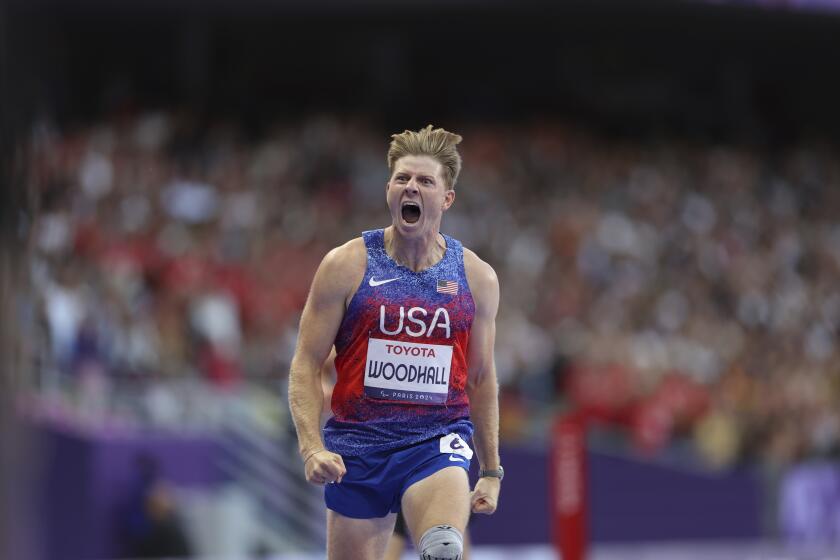Johnson’s Secret Becomes Team Effort : Track and field: Doctors and coaches help him mask a stress fracture to keep opponents, journalists in the dark.
BARCELONA — Terry Franson sure can keep a secret. For two weeks he has known that the man he coaches, Dave Johnson, America’s gold-medal favorite in the decathlon, has had a stress fracture in his right foot.
Doctors have known, podiatrists and U.S. Olympic Committee physicians have known.
At Franson’s request, none was forthcoming when asked about Johnson’s injury. They all can keep secrets.
Johnson has known since the day it happened, probably June 10, the doctors believe. He kept his secret through most of the first day of the two-day decathlon. He hinted at the problem Wednesday night by saying he would tell the whole story Thursday. But he had kept his secret until he could keep it no longer.
During Wednesday’s competition, it grew more and more apparent that Johnson, despite his statements to the contrary, was experiencing significant physical trouble.
But not according to James Montgomery, the USOC team physician. He said, when asked, that Johnson’s problem amounted to no more than a “stone bruise.”
It wasn’t true, but it was part of the plan.
“I’ve got an athlete that I’ve got to keep together,” Franson said. “He wanted to know everything, but I don’t want him to dwell on the problem. The more people who knew, the worse it was. We made the decision to keep it secret.”
In order not to betray his secret, Johnson was called on to become an actor. He said that if his competitors got any hint that he was weakened, they would pounce on him with renewed vigor.
“Can’t let them know,” Johnson said. “If I know that athletes are injured, it gives me that much more motivation. It was also because I didn’t want to have another thing to deal with. It seemed better to keep it quiet.”
The problem began before the U.S. Olympic trials in June. Johnson said he was in the middle of a running workout when he felt a snap and heard a pop. The sound Johnson heard was the navicular bone at the top of his right foot cracking. A crack grew, developed after years of stress on the joint and, possibly, a structural problem with Johnson’s arch.
The condition was painful but bearable during the trials, which Johnson won. But afterward, the pain increased. Johnson, who lives in Pomona, consulted a group of podiatrists and other doctors, who advised extensive X-rays and a magnetic resonance imaging test, which provides a comprehensive insight to bone and tissue.
“At first they told us there was nothing,” Franson said. “Then they called back and said they found something. We went back and they told us they found a crack. That bone is beat up. We spent 30 hours that week with doctors.”
The outlook was bleak. The navicular bone, on top of the foot above the arch, doesn’t get a good blood supply and is slow in healing. Also, a mid-foot fracture is the most painful.
The pressing question: Could Johnson compete? He was told that there was a 20% chance that the bone would break during the competition. He was told it would be extremely painful. He also was told that unless he insisted on competing in the Olympics, a cast would be put on his foot.
Johnson insisted on competing. To prevent further injury to the foot, Franson made July 17 the last day of conventional training. Johnson has maintained his aerobic capacity by riding a stationary bike, working in a pool and lifting weights. Franson said Johnson’s half-mile jog a week ago was the only running the decathlete has done since then.
In accepting the risk of further injury, Johnson also took on the kind of pain that could be debilitating. Larry Rink, the Olympic physician for track and field, described the condition as causing, “an incredible amount of pain.”
Johnson was more graphic.
“First it was like a small knife,” he said, referring to the portion of time early in the day when the pain was under control. “After the vault, it felt like a sledgehammer.”
Franson said Rink was standing by at the track Thursday, ready to inject a painkilling drug into Johnson’s foot if Johnson asked. He didn’t ask, although he sprained his right ankle during the pole vault, causing his entire foot to swell even more.
How well Johnson masked all this during the first day is questionable. At the end of Wednesday’s competition, Johnson acknowledged that there was a serious problem with his foot, disclosing his own secret.
The ruse posed a curious situation for Johnson, a devout Christian. He essentially had asked his coach, doctors and friends to lie.
“I didn’t like that at all,” he said. “I wanted to tell everybody.”
Not even his shoe company, Reebok, was aware of the injury. Reebok held more than a passing interest in Johnson’s welfare. The company likes him and has invested $25 million into an advertising campaign that had halfway fallen through when Dan O’Brien failed to make the U.S. Olympic team.
Another problem was caused by the image of a shoe-company spokesman limping around a track with foot pain.
In the end, Johnson was able to finish and win a bronze medal. He expects that with time and therapy, he will be fine.
And Reebok won, too. The gold medalist, Robert Zmelick of Czechoslovakia, wears Reeboks. And his feet don’t even hurt.
More to Read
Go beyond the scoreboard
Get the latest on L.A.'s teams in the daily Sports Report newsletter.
You may occasionally receive promotional content from the Los Angeles Times.








